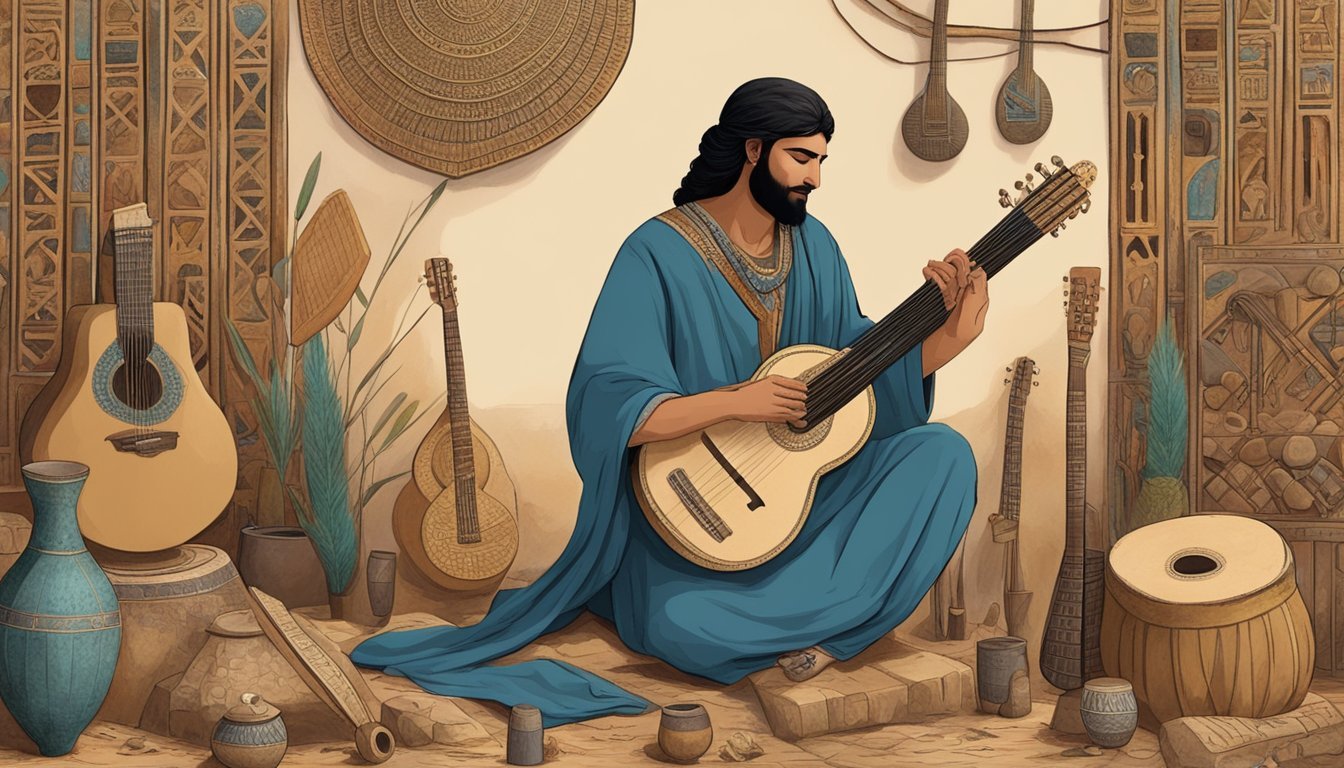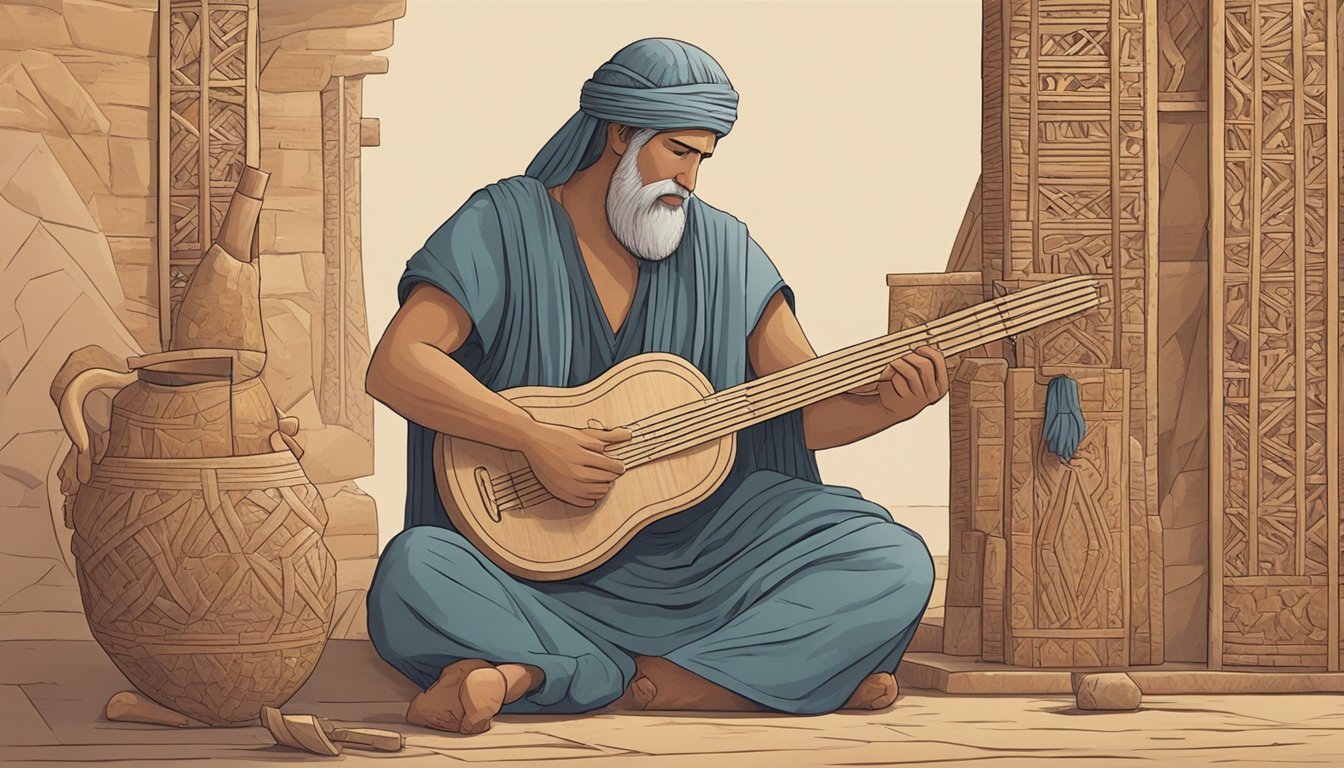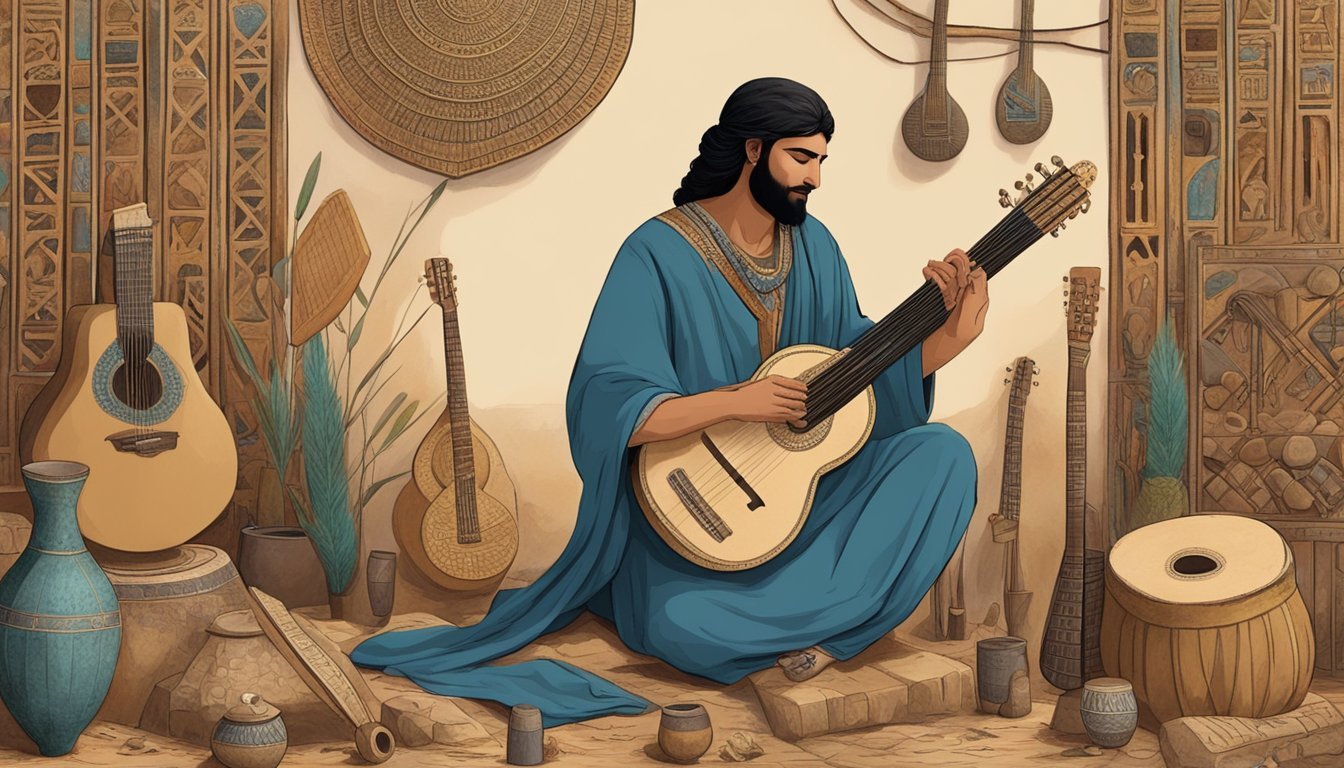The guitar, a beloved stringed instrument, has an interesting history that dates back centuries. The guitar’s origins can be traced to Spain in the early 16th century.
It evolved from the guitarra latina. Over time, it transformed through various influences and designs, leading to the modern acoustic and electric guitars we know today.

As you explore the journey of the guitar, you’ll discover how it shaped musical styles around the world.
From its ancient predecessors to the vibrant sounds of contemporary music, the guitar remains a key part of cultural expression.
The connection between the instrument and musicians is profound, making it a staple in many genres.
The story of the guitar is not just about its invention; it reflects a rich tapestry of creativity and passion.
Whether you’re a player or just a fan, understanding its history enhances your appreciation for this remarkable instrument.
Key Takeaways
- The guitar’s roots trace back to Spain in the early 16th century.
- It has evolved significantly over time, influencing various musical styles.
- Knowing its history enriches your connection with the instrument.
Early Predecessors and Evolution

The guitar has a rich history that begins with various stringed instruments from ancient times.
This evolution shows how these early creations influenced the modern guitar you know today.
Understanding its roots helps you appreciate its development throughout the ages.
Ancient Roots and Ancestors
The guitar journey starts with ancient string instruments.
The oud is one of the oldest examples, originating in Mesopotamia.
It has a rounded back and no frets, much like some modern guitars.
Another key ancestor is the kithara, a Greek version used in various ceremonies.
Around the same time, the cithara started making waves in Europe.
Later on, the tanbur, popular in regions like the Middle East, contributed to shaping stringed instruments in Europe.
As time went on, various European instruments like the lute and vihuela began to emerge.
These early instruments had a significant impact on the development of the guitar’s body and strings.
Their influence clearly set the stage for a new era of stringed instruments.
Transition to the Modern Guitar
Fast forward to Medieval Spain, where the guitarra latina began to take form in music circles.
This instrument laid the groundwork for the gittern and later the baroque guitar.
Each evolution brought unique features, including changes to the soundboard and the overall shape.
By the Renaissance, the instrument continued to change, introducing the baroque guitar with a wider body and x-bracing.
This innovation improved sound projection and tonal quality.
With the arrival of Antonio de Torres Jurado in the 19th century, the modern guitar really started to take shape.
He introduced significant design innovations that influenced all guitars that followed.
Cultural and Musical Impact

The guitar has shaped music and culture for centuries.
Its versatility allows it to fit into many genres, while legendary players have left their mark on music history.
Guitar Across Genres
The guitar is present in nearly every music genre you can think of.
In classical music, the acoustic guitar has a refined voice, adding warmth to orchestras. Blues guitar shines with expressive bends and soulful tones.
In genres like rock, the electric guitar takes center stage.
Think of the power of guitar solos that define many rock anthems.
From heavy metal to folk music, guitar styles vary widely.
You can find intricate fingerpicking in flamenco and catchy riffs in country.
The versatility of the guitar shows in genres like jazz too, where players create complex melodies.
From jazz guitar legends to modern interpretations, the guitar’s adaptability keeps it relevant.
Iconic Guitar Players
Great guitarists have changed the landscape of music.
For example, Jimi Hendrix revolutionized rock with his innovative sound and showmanship.
His wild solos and techniques opened new doors for guitar music.
Eric Clapton has made waves across genres, merging blues and rock like no one else.
His skillful style in both lead guitar and rhythm makes him a standout.
Then there’s Stevie Ray Vaughan, known for his heartfelt blues guitar.
His passion and technical prowess inspired countless musicians.
Andrés Segovia brought classical guitar to the forefront, making it widely respected.
In the world of jazz, Charlie Christian was a game changer.
His work helped shape the role of the guitar in a jazz ensemble.
Design and Construction

When learning about guitars, it’s important to understand their anatomy and how the body has evolved over time.
This knowledge helps you appreciate the artistry and engineering behind these popular instruments.
Anatomy of the Guitar
The guitar is made up of several key parts that contribute to its sound and playability.
At the heart of the guitar is the soundboard, which is usually made from solid wood.
This is crucial because it amplifies sound when you strum or pluck the strings.
The sound hole helps project the sound, while the belly is slightly raised above the surface to aid in resonance.
Then there are the pickups—especially in electric guitars—where they act as an electromagnetic device to amplify the vibrations from the strings.
Each guitar has a fingerboard where you press down on the nylon or steel strings to create different notes.
Most guitars follow standard tuning, making it easier for musicians to play together.
Evolution of the Guitar Body
The guitar has undergone significant changes in its design and construction over centuries.
Early guitars had smaller bodies and were often made with double courses, meaning each string had a pair.
Over time, innovators like Antonio de Torres Jurado and Christian Frederick Martin made advances that shaped modern guitars.
With the introduction of flat top acoustic guitars, builders started using steel guitar strings to create a brighter sound.
Later, Gibson and Fender popularized solid-body guitars and archtop guitars.
These advancements allowed for different styles and genres, particularly in jazz and rock.
Today, brands like Yamaha offer a variety of guitars that reflect decades of evolution while catering to players’ needs.
Guitar in the Modern Era
The guitar has changed a lot in the modern era, thanks to new technology and easier access to learning.
You can see how these developments have shaped the instrument and its role in music today.
Technological Advancements
Modern guitars come with many advancements.
Electric guitars, like the Fender Telecaster, have transformed music genres.
The introduction of solid body guitars improved sound quality.
Amplification has allowed guitarists to play in larger venues.
With the use of pickups, electric guitars can create a variety of sounds.
You can get distorted tones for rock music or crisp sounds for jazz.
Moreover, innovations in materials and design have made guitars lighter and more durable.
Nylon strings, often used in classical music, now also appear on some modern guitars.
This gives you different tonal options to explore.
Accessibility and Education
Learning to play guitar has never been easier.
Many online courses and video tutorials make education accessible to everyone.
You can find lessons on how to play the latest hits or master guitar solos.
Guitar tablature has simplified the learning process.
It’s a straightforward way to read music for beginners.
You don’t need to know traditional music notation to start playing.
This accessibility opens up the world of music to many who might be intimidated by standard sheet music.
Moreover, learning through tablature allows beginners to quickly pick up their favorite songs, fostering a sense of accomplishment early on.
Whether you’re trying to figure out how to spell guitar correctly or mastering your first chords, tablature provides a practical and engaging path to musical expression.
As popular music continues to evolve, so do the styles of playing.
You can choose to learn electric guitar techniques or focus on modern acoustic guitars.
No matter your preference, the resources available cater to all levels.
Frequently Asked Questions
There are many interesting facts about the guitar’s history and its evolution.
Let’s dive into some common questions that people often have about when the guitar was invented and how it changed over time.
When was the electric guitar first introduced?
The electric guitar was introduced in the early 1930s.
George Beauchamp and Adolph Rickenbacker created the first commercially successful electric guitar.
This guitar, known as the “Frying Pan,” helped change the music scene forever.
Who invented the modern guitar, and when did that happen?
The modern guitar evolved over many years, but one key figure is Antonio de Torres, a Spanish builder.
He made significant changes in the mid-1800s, setting the standard for modern acoustic guitars.
His designs have influenced guitar making ever since.
Can you tell me when the acoustic guitar made its debut?
The acoustic guitar has roots that go back to ancient stringed instruments.
It began to take shape in the 15th century but became more recognizable in its modern form by the late 19th century.
Many cultures contributed to its evolution during this time.
What’s the history behind the first ever guitar?
The earliest ancestors of the guitar can be traced back to instruments like the lute and the vihuela.
These instruments existed centuries ago, often in Europe and the Middle East.
The term “guitar” starts appearing in documents by the 13th century.
How did the six-string guitar come into existence?
The six-string guitar became popular in the 19th century.
While earlier guitars had different numbers of strings, builders found that six strings offered the right balance for sound and playability.
It became the standard format that most players use today.
What’s the backstory of the guitar making its way to America?
Guitars made their way to America in the 1800s through European immigrants.
As popular music styles like blues and folk developed, the guitar became a key instrument in American music.
Its popularity has only grown since then, shaping a wide range of musical genres.

